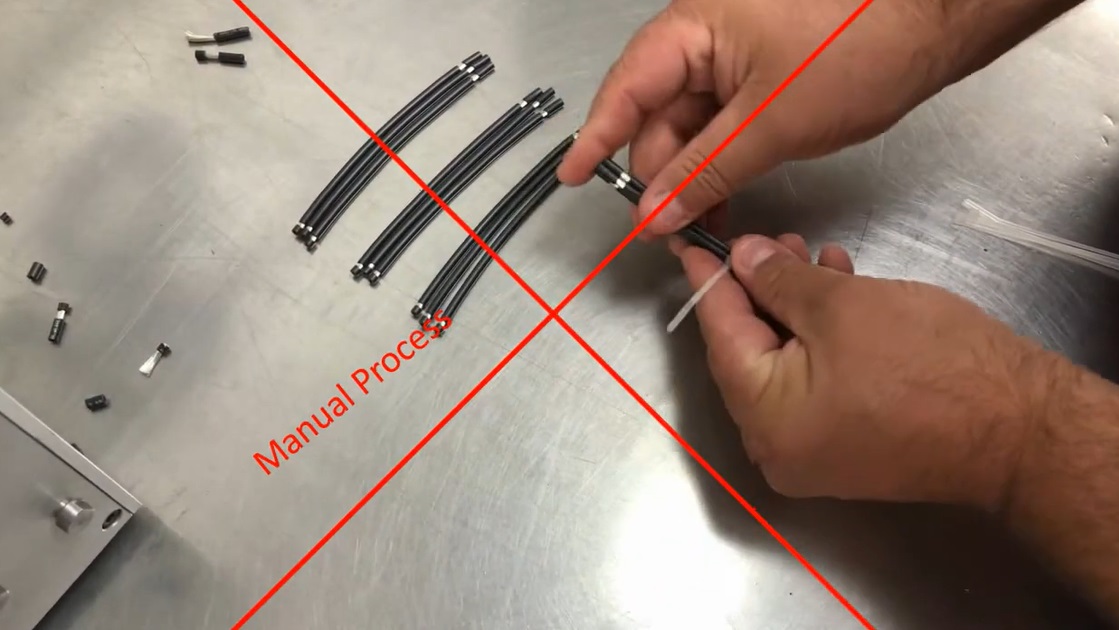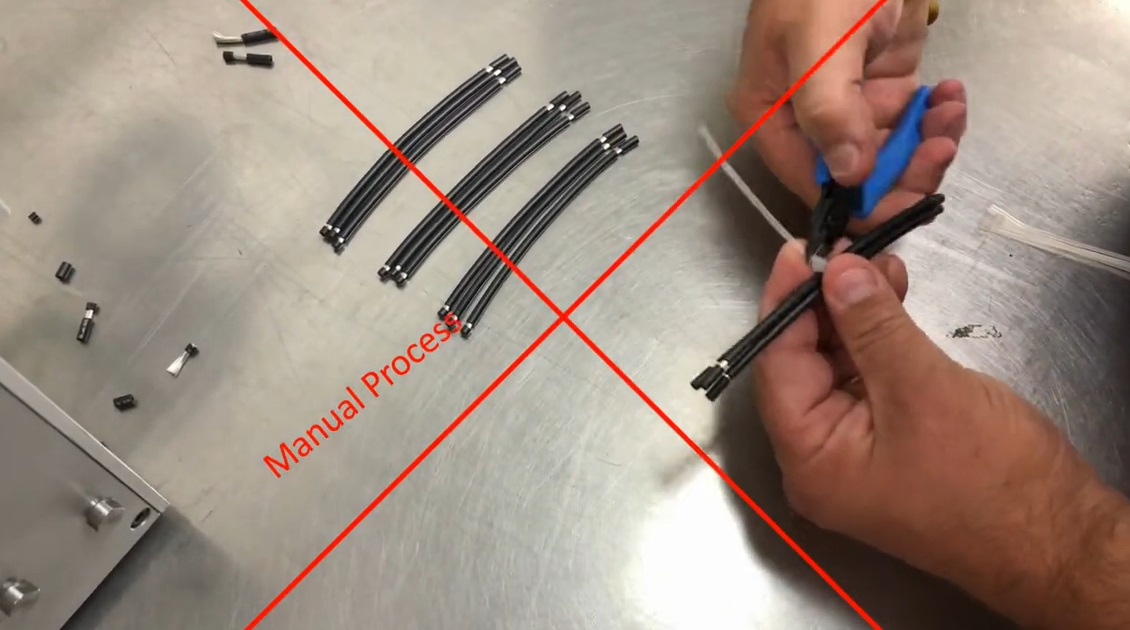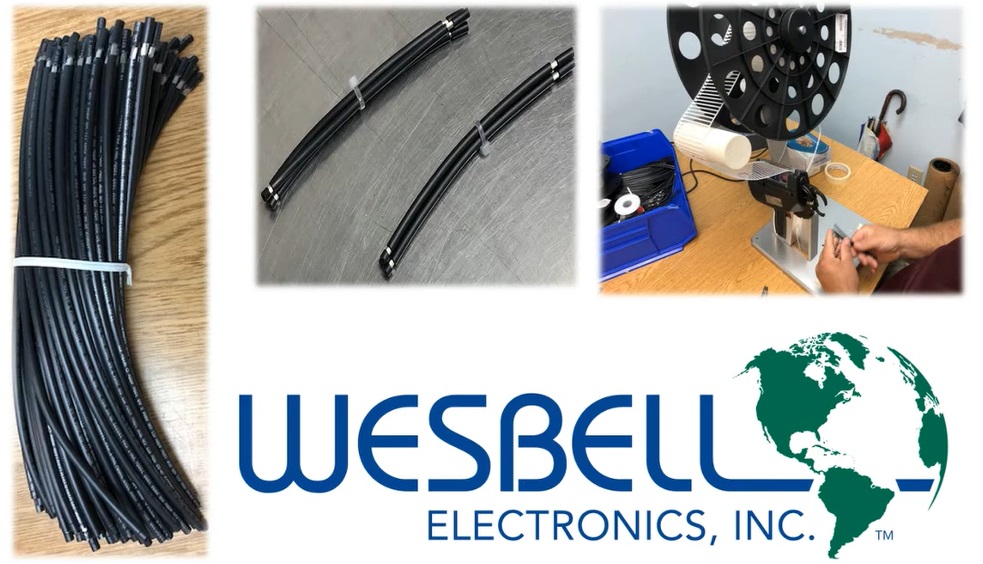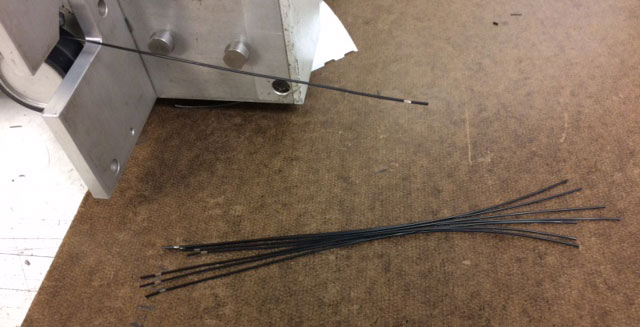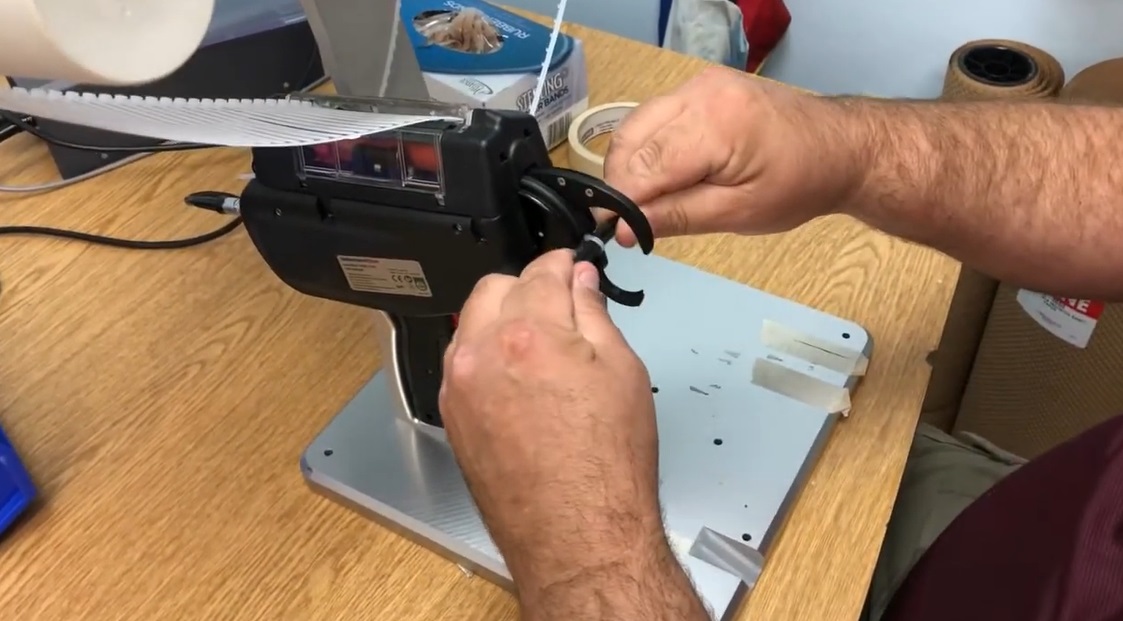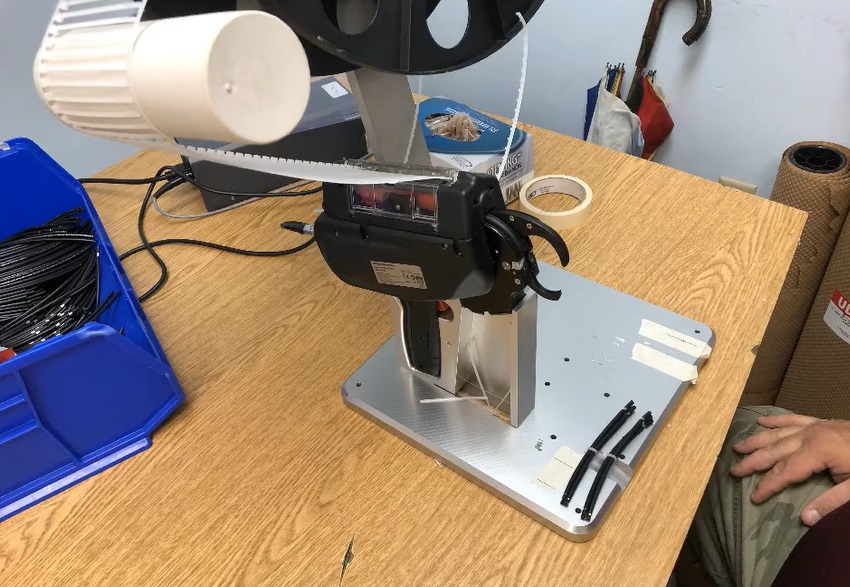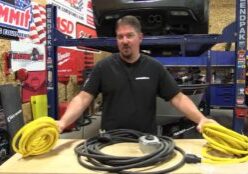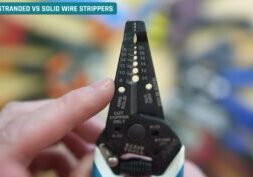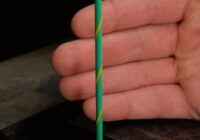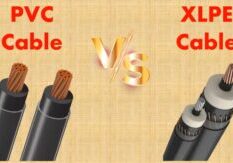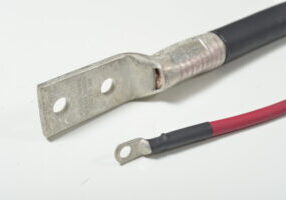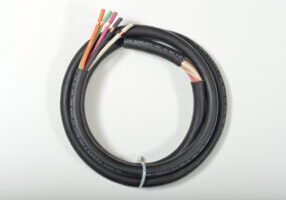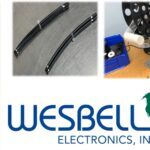
Oct 8, 2024
Automated Tie Wrapping Hook up Wire Bundles (UL1015 12 awg)
Manual Process of Cutting and Bundling 3 Lead Wires
- Preparation:
- Before you start the process of cutting and bundling lead wires, the first step is to ensure you have the necessary tools. The most essential tools for manual cutting and bundling are:
- Wire cutters or cable snips for cutting the wires to the required lengths.
- Measuring tape to ensure that the wires are cut to the correct and equal lengths.
- Tie wraps (also known as zip ties) to bundle the wires together.
- Wire strippers to remove the insulation at the ends of the lead wires if needed.
- The workspace should be organized and free of obstacles to avoid accidents, as cutting wires involves sharp tools. Ideally, a workbench or table will provide a solid base for measuring and cutting wires accurately.
- Before you start the process of cutting and bundling lead wires, the first step is to ensure you have the necessary tools. The most essential tools for manual cutting and bundling are:
- Measuring and Cutting the Wires:
- First, you need to measure the length of the three lead wires you are working with. Depending on the application, each lead wire should be of a specific length.
- Place the measuring tape along the length of the wire spool and measure out the desired length. Mark the wire with a pen, piece of tape, or simply hold the place where the cut is to be made.
- Using wire cutters or snips, carefully cut through the first wire at the marked point. Be sure to make clean cuts to prevent fraying of the conductor inside the insulation.
- Repeat this process for the remaining two wires, ensuring all three wires are cut to the same length. This is especially important in applications like electrical or industrial work, where uniformity can affect the performance or safety of the setup.
- Arranging the Wires for Bundling:
- Once all three lead wires are cut to the desired lengths, they should be arranged parallel to one another. Align the ends of the wires so that they are even, as this will make bundling easier and provide a cleaner appearance.
- While holding the three wires together, ensure that the arrangement is as tight and neat as possible. The wires should not be twisted or overlapping one another unevenly.
- Applying the Tie Wraps (Zip Ties):
- After arranging the three hook up wires together, use a tie wrap to begin the bundling process. Starting about 1-2 inches from one end of the wire bundle, wrap a tie wrap around all three wires and pull it tight to hold them together.
- Ensure the tie wrap is snug, but be careful not to over-tighten it, as this can crush or damage the insulation on the wires, which may compromise their integrity and performance.
- Space additional tie wraps along the length of the bundle at regular intervals, typically every 6-12 inches, depending on the total length of the wires. This will prevent the wires from shifting or becoming loose.
- After each tie wrap is applied, trim the excess end with wire cutters to prevent sharp or protruding ends that could cause injury or snagging during installation or use.
- This process can be time-consuming, as manually handling each tie wrap and ensuring uniform tension on all the tie wraps requires precision.
- Final Inspection:
- Once the wires are bundled, the final step is to inspect the bundle to ensure that the wires are securely fastened, and the tie wraps are evenly spaced and not overly tight.
- Check for any damage to the insulation, especially where the tie wraps have been applied. If any wires appear damaged, frayed, or crushed, it may be necessary to cut them and start over to ensure safety and performance.
Faster Automated Version Using a Hydraulic Foot Pedal Machine
While the manual process of cutting and bundling lead wires is relatively straightforward, it can be slow and labor-intensive, particularly in environments where high volumes of wires need to be processed. This is where an automated system, such as a hydraulic foot pedal machine, offers significant advantages in terms of speed, consistency, and quality.
- Overview of the Hydraulic Foot Pedal Machine:
- A hydraulic foot pedal machine is designed to automate the processes of cutting, bundling, and securing lead wires, thereby drastically reducing the manual labor involved.
- The machine typically consists of several components, including:
- A hydraulic press or cutting mechanism that can quickly and accurately cut the wires to the required lengths.
- A bundling station equipped with automated tie wrap applicators or cable harness devices.
- A foot pedal control system that allows the operator to initiate and control the machine’s functions while keeping both hands free for other tasks.
- The hydraulic system provides the necessary force for cutting and securing wires without requiring significant physical effort from the operator.
- Automated Cutting Process:
- The cutting process in a hydraulic foot pedal machine is highly efficient. Instead of measuring and cutting each wire manually, the machine can be programmed to cut the wires to precise lengths automatically.
- The operator simply inputs the desired wire length, and the machine feeds the wire through a cutting mechanism powered by hydraulic pressure. This ensures clean, consistent cuts every time.
- Unlike manual cutting, where variations in length or uneven cuts can occur, the machine provides exact, repeatable results, reducing the risk of errors and waste.
- The foot pedal control allows the operator to quickly cut multiple wires in succession without having to handle the cutting tool directly. This significantly increases the speed of production.
- Automated Bundling Process:
- After the wires are cut, the bundling process begins. In a manual setup, arranging the wires and applying tie wraps is a time-consuming step. However, in an automated system, the wires can be arranged and bundled with minimal manual handling.
- The operator feeds the cut wires into the bundling station, where the machine automatically arranges the wires in parallel.
- The machine applies tie wraps at regular intervals along the length of the wire bundle using pre-programmed settings. The tension on each tie wrap is precisely controlled by the machine, ensuring consistent pressure and reducing the risk of over-tightening or damaging the wires.
- The foot pedal system allows the operator to initiate the bundling process with ease, freeing their hands for other tasks or preparation of additional wire sets.
- Advantages in Speed and Efficiency:
- One of the primary advantages of using a hydraulic foot pedal machine is the speed at which wires can be processed. What may take several minutes to do manually—measuring, cutting, bundling—can be completed in a fraction of the time with automation.
- For instance, cutting and bundling three lead wires manually could take 5-10 minutes, depending on the length and complexity of the bundle. The hydraulic machine can perform the same task in seconds, cutting down production times dramatically.
- The ability to automate repetitive tasks means that operators can focus on quality control or other higher-value tasks, rather than spending excessive time on manual wire handling.
- Quality and Consistency Improvements:
- Another significant benefit of the hydraulic foot pedal machine is the consistency and quality of the output. Manual processes are prone to human error, such as uneven cutting, improper tension on tie wraps, or damage to the wire insulation. In contrast, the machine delivers uniform results with every cycle.
- The automated cutting mechanism ensures that each wire is the exact same length, eliminating discrepancies that could lead to performance issues in the final application.
- Similarly, the automated bundling system applies tie wraps with uniform pressure, preventing under- or over-tightening. This reduces the risk of damage to the wires and ensures a more durable and professional-looking bundle.
- The machine also reduces strain on the operator. Repetitive tasks like cutting and bundling can lead to fatigue, which in turn can result in errors or accidents. By automating these processes, the hydraulic machine reduces physical strain and helps maintain a high level of quality control.
- Safety and Ergonomics:
- The hydraulic foot pedal machine offers several safety and ergonomic benefits over manual wire processing.
- By using foot pedals, the operator can keep their hands free for other tasks and avoid handling sharp tools like wire cutters, reducing the risk of hand injuries.
- The machine’s controlled, precise cutting and bundling mechanisms minimize the risk of damaging wires or accidentally cutting oneself, as all cutting and wrapping operations are enclosed and operated automatically.
- Additionally, the automation reduces repetitive strain injuries that can result from manually cutting and bundling large volumes of wire.
- Cost Efficiency:
- While hydraulic foot pedal machines require an upfront investment, the long-term cost savings can be significant. The speed and consistency of the machine reduce labor costs, as fewer workers are needed to achieve the same output compared to a manual process.
- Moreover, the reduction in material waste from inaccurate cuts or damaged wires contributes to overall cost savings. In industries where precision and efficiency are critical, the investment in automation often pays for itself through increased productivity and reduced error rates.
Conclusion:
In summary, while the manual process of cutting and bundling lead wires using tie wraps is relatively simple, it can be labor-intensive, slow, and prone to errors. The introduction of an automated hydraulic foot pedal machine offers substantial benefits in terms of speed, consistency, and overall efficiency. Automated cutting ensures precision, while the bundling process guarantees uniform tension on tie wraps, leading to higher-quality wire bundles. Additionally, automation reduces operator fatigue, enhances workplace safety, and improves ergonomics. For industries that require the processing of large volumes of wire, the shift from manual to automated systems is a clear improvement in both productivity and quality.

